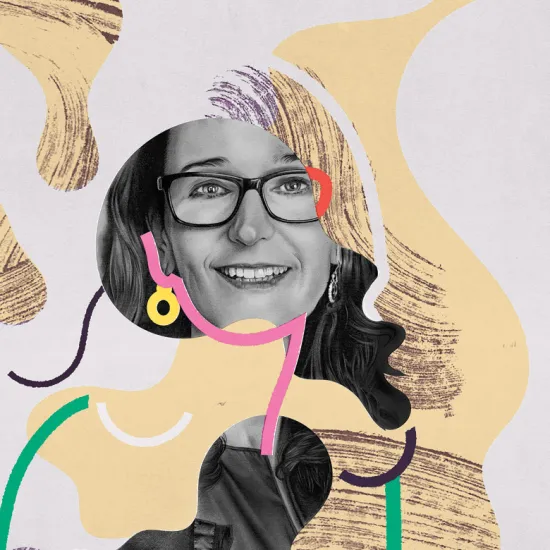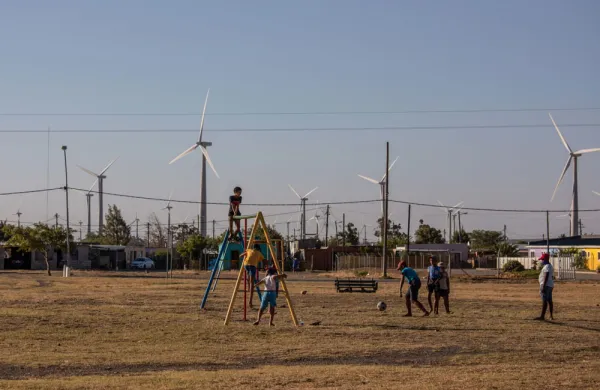Teresa Barger tells me that growing up in Saudi Arabia was boring, but to this native Midwesterner, her childhood sounds like something out of the movies.
Barger is the co-founder and CEO of Washington, D.C.–based Cartica Management, an activist firm that invests exclusively in emerging markets. Her parents, both from North Dakota, raised Barger and her five siblings in an oil camp in Saudi Arabia, where her father, Thomas, was an executive at oil company Aramco, eventually becoming its chief executive. Her mother’s past also was decidedly not boring: Kathleen Ray was a rodeo star in western North Dakota until the early 1940s. Although Thomas — a mining and metallurgy engineer who set a record by getting from North Dakota to Saudi Arabia in 12 days for his new job as a surveyor in the 1930s — and her mother often took their kids traveling around the world for months at a time, Barger says she relied on her imagination for entertainment in what she calls a “cultural desert.”
Barger says this cultivation of her imagination paid off in adulthood, as it plays a crucial role in her day job at Cartica, which invests in family- and founder-controlled companies. The firm, which has 20 companies in its portfolio, makes money by persuading companies to fix their corporate governance issues, and identify and improve environmental and social risks. Barger emphasizes that Cartica’s brand of activism is about “engagement,” or constructive activism, as the firm is a minority investor and can’t threaten companies with proxy battles.
When she’s not traveling to other countries in search of corporate diamonds in the rough, Barger is a fine-art aficionado; she thinks the creation of art offers many parallels to investing. As the affable, chatty Barger shows me around the National Gallery of Art in Washington, she points out the details — stockings that are dirty, a foreshortened sword laying at the feet of an actor playing Hamlet — that can construct a narrative from the incomplete information available from the canvas.
“I think investing is a creative process like we see at the art museum,” says Barger, clad in a long black vest embroidered with red beads and metal. It’s a creation by one of her two daughters, Amelia Brown, a high-end fashion designer who uses colors and styles from the countries she herself has lived in, including Morocco and Tunisia.
Of course, there is an analytical component to her process as well. Barger explains that Cartica, which now has $3.2 billion in assets after a slow start — it launched smack in the middle of the global financial crisis — first chooses the countries in which to invest. She learned the importance of country selection during her 21 years at the International Finance Corp., the private sector development arm of the World Bank, where she headed corporate governance before going out on her own. “At Cartica, when there are market downturns, our funds come down less than the benchmark and recover sooner than the benchmark because of the country effect,” she says. But company selection is where the alpha comes from, she explains. Through her work at the IFC, Barger found that the best-performing companies in emerging markets were those that had improved their corporate governance.
As we talk, Barger heads toward a work by one of her favorite painters, Edouard Manet. Standing in front of Manet’s The Railway, Barger pulls on the thread of a story: There’s a woman staring directly at the viewer, with a velvet choker, the sign of a prostitute. There’s the tanned back — and contrasting pale arms — of a child, and clouds of smoke, the only signs of a train in the painting.
Barger links it back to investing. “You have to have the imagination to understand what all the various forces are that might help or hinder a company as they execute in the future. This is particularly true now when the future is not going to look like the past,” she says.
Pausing in front of Edouard Vuillard’s Portrait of Théodore Duret, Barger says she loves this painting, which depicts a man — possibly a lawyer — at a desk covered with papers and stacked high with books. The viewer’s eye is drawn through multiple windows, door frames, and mirrors in the background. The scene feels cluttered, with multiple points of view and many places for the eye to rest.
“That’s what Cartica does as an investor: sorts through the disorder,” she says. “What makes the business model tick? The culture, the CEO tick? Is everyone rowing in the same direction?”
She tells the story of visiting a Taiwanese company that makes forged aluminum wheels for luxury cars, one of only two such concerns in the world. But when Barger visited a plant, she saw a filthy, oily floor where workers weren’t wearing protective gear. “Every car company wants two suppliers of anything, and here was one, but this was a disaster.” In this case, the disorder was in plain sight — once she visited. “We didn’t invest,” she says.
Cartica instead relies on giving valuable ideas to families and providing tools like its reports that benchmark company boards. “We recently told a CEO that his $4 billion company was worth $5 billion on a sum-of-the-parts basis,” she says. “He was all over it. You’re there making your widgets and in the emerging markets people aren’t always thinking about how the capital markets work.”
Barger started Cartica at the end of 2007 with Farida Khambata, IFC’s head of operations in East Asia and the Pacific, South Asia, Latin America, and the Caribbean; Michael Lubrano, an early leader in fostering good corporate governance practices in the emerging markets; and Steven Quamme, who co-founded a U.S. activist fund that had pension investors. But their timing couldn’t have been worse.
A consultant for the California Public Employees’ Retirement System issued its report on Cartica on September 15, just days before Lehman Brothers’ bankruptcy filing. Nevertheless, CalPERS approved the investment. With CalPERS’ money, Cartica started investing in 2009. “Farida and I were international civil servants our whole lives. I put 50 percent of my net worth in the fund — not a big number, but big for me,” Barger says. The fund racked up good numbers its first year, and by year three, the four founders were succeeding.
As Barger explains, Cartica invests in good companies with good management teams, but they don’t always understand certain things that are important in developed capital markets, including disclosure. “We ask companies, ‘Why aren’t you telling your story, one that is coherent and backed up by numbers?’” she says. One of Cartica’s investments, Alsea, a franchisor in Mexico that operates brands like Starbucks, California Pizza Kitchen, and Burger King, wasn’t disclosing information by business segment or geography, so investors didn’t know whether they were allocating capital to a broken brand like Burger King or a growing one like Starbucks. After Cartica convinced the company to change its reporting, the stock went up 10 percent in a week.
The anecdote brings the conversation back around to art. In front of a Renoir self-portrait at the gallery, Barger says, “We’re trying to get people to draw their own self-portrait. No one will know what you do if you don’t tell them.”







